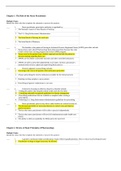Essay
Unit 10 Aim A: Biological Molecules Assignment (DISTINCTION)
- Institution
- PEARSON (PEARSON)
This is my distinction grade assignment for unit 10 aim A on biological molecules: water, lipids, proteins and amino acids. All criteria were met and I was awarded distinction. If you have any questions or concerns, please do not hesitate to get in touch. I hope you find my assignment helpf...
[Show more]












